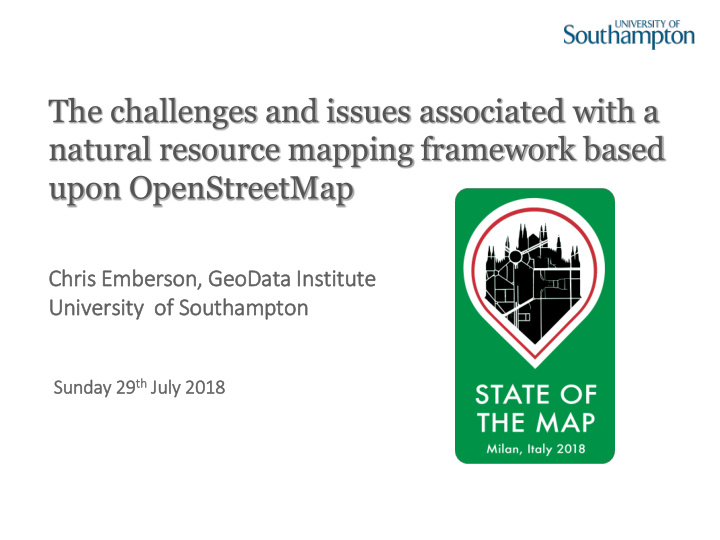



The challenges and issues associated with a natural resource mapping framework based upon OpenStreetMap Chris Emberson, GeoData Institute University of Southampton Sunday 29 th July 2018
The RADIMA project
Aims and Objectives Aims (of the project) • To develop an open tool for sub-national, county-level climate adaptation planning • Targeted at vulnerable communities who are often marginalised and / or misrepresented • Integration of community adaptive practice into planning decisions Objectives (of the system) • To capture local knowledge from communities whose livelihoods depend upon natural resources • To depict the inherent (spatial and temporal) variation in pastoral mobility • To be flexible enough to evolve over time (with our changing climate)
Meeting the needs of (Kenyan) national initiatives The extendable data model of OSM is a good fit for RADIMA. It is adaptable to capture the key elements of both the County Integrated Development Plan (CIDP) and the County Spatial Plan (CSP) for Kenya: CIDP: �refer to �aps, statisti�s a�d other appropriate do�u�e�ts that are �ot atta�hed �ut held i� a GI“ �ased data�ase syste�� CSP: �prote�t a�d i�tegrate rights a�d i�terest of �i�orities a�d �argi�alized groups a�d �o��u�ities� �prote�t a�d develop �atural resour�es i� a �a��er that alig�s �atio�al a�d �ou�ty gover��e�ts poli�ies� �[Must provide] a spatial depi�tio� of the so�ial a�d e�o�o�i� develop�e�t progra��e of the �ou�ty� Source: Parliament of Kenya http://www.parliament.go.ke/statutory-documents?start=27
Areas covered (so far)
Capturi�g lo�al pastoralist k�o�ledge…
Granularity of data – the availability of water
Granularity of data – the availability of water
Granularity of data – the availability of water
More gra�ularity….. Grass types and nutritional value - pasture designation pasture salt source grassland type leaf type, leaf cycle conditions of access – free / paid / reciprocity protected area conflict …�a�y �ore!!
Challe�ges…..a�d �urre�t de�elop�e�ts Who can / should be able to edit the data? How can adaptation measures be captured in a mapping framework? Gaps in the data E�gagi�g lo�al �o��u�ities to �o��� the �appi�g process.
Summary Gro�i�g �eed to �apture the �less �isi�le� attri�utes of natural resources in Arid / Semi-Arid Lands (ASALs) Recognition of the value of accurate mapped data exists and is a key element of future plans for ASALs in Sub-Saharan Africa Challenges exist, but clearly uptake and momentum are key – The need for pastoralists to get mapping has �argua�ly!� �e�er �ee� greater…..
Thank you for listening! Chris Emberson GeoData Insititute University Of Southampton cre@geodata.soton.ac.uk
Recommend
More recommend